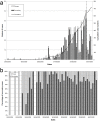Onset of a pandemic: characterizing the initial phase of the swine flu (H1N1) epidemic in Israel
- PMID: 21492430
- PMCID: PMC3098178
- DOI: 10.1186/1471-2334-11-92
Onset of a pandemic: characterizing the initial phase of the swine flu (H1N1) epidemic in Israel
Abstract
Background: The swine influenza H1N1 first identified in Mexico, spread rapidly across the globe and is considered the fastest moving pandemic in history. The early phase of an outbreak, in which data is relatively scarce, presents scientific challenges on key issues such as: scale, severity and immunity which are fundamental for establishing sound and rapid policy schemes. Our analysis of an Israeli dataset aims at understanding the spatio-temporal dynamics of H1N1 in its initial phase.
Methods: We constructed and analyzed a unique dataset from Israel on all confirmed cases (between April 26 to July 7, 2009), representing most swine flu cases in this period. We estimated and characterized fundamental epidemiological features of the pandemic in Israel (e.g. effective reproductive number, age-class distribution, at-risk social groups, infections between sexes, and spatial dynamics). Contact data collected during this stage was used to estimate the generation time distribution of the pandemic.
Results: We found a low effective reproductive number (Re=1.06), an age-class distribution of infected individuals (skewed towards ages 18-25), at-risk social groups (soldiers and ultra Orthodox Jews), and significant differences in infections between sexes (skewed towards males). In terms of spatial dynamics, the pandemic spread from the central coastal plain of Israel to other regions, with higher infection rates in more densely populated sub-districts with higher income households.
Conclusions: Analysis of high quality data holds much promise in reducing uncertainty regarding fundamental aspects of the initial phase of an outbreak (e.g. the effective reproductive number Re, age-class distribution, at-risk social groups). The formulation for determining the effective reproductive number Re used here has many advantages for studying the initial phase of the outbreak since it neither assumes exponential growth of infectives and is independent of the reporting rate. The finding of a low Re (close to unity threshold), combined with identification of social groups with high transmission rates would have enabled the containment of swine flu during the summer in Israel. Our unique use of contact data provided new insights into the differential dynamics of influenza in different ages and sexes, and should be promoted in future epidemiological studies. Thus our work highlights the importance of conducting a comprehensive study of the initial stage of a pandemic in real time.
Figures








Similar articles
-
Age-specific contacts and travel patterns in the spatial spread of 2009 H1N1 influenza pandemic.BMC Infect Dis. 2013 Apr 15;13:176. doi: 10.1186/1471-2334-13-176. BMC Infect Dis. 2013. PMID: 23587010 Free PMC article.
-
Impact of antiviral treatment and hospital admission delay on risk of death associated with 2009 A/H1N1 pandemic influenza in Mexico.BMC Infect Dis. 2012 Apr 20;12:97. doi: 10.1186/1471-2334-12-97. BMC Infect Dis. 2012. PMID: 22520743 Free PMC article.
-
The dynamics of infection and the persistence of immunity to A(H1N1)pdm09 virus in Israel.Influenza Other Respir Viruses. 2013 Sep;7(5):838-46. doi: 10.1111/irv.12071. Epub 2012 Dec 22. Influenza Other Respir Viruses. 2013. PMID: 23280061 Free PMC article.
-
The influence of climatic conditions on the transmission dynamics of the 2009 A/H1N1 influenza pandemic in Chile.BMC Infect Dis. 2012 Nov 13;12:298. doi: 10.1186/1471-2334-12-298. BMC Infect Dis. 2012. PMID: 23148597 Free PMC article.
-
Transmission parameters of the A/H1N1 (2009) influenza virus pandemic: a review.Influenza Other Respir Viruses. 2011 Sep;5(5):306-16. doi: 10.1111/j.1750-2659.2011.00234.x. Epub 2011 Mar 31. Influenza Other Respir Viruses. 2011. PMID: 21668690 Free PMC article. Review.
Cited by
-
Assessing changes in incubation period, serial interval, and generation time of SARS-CoV-2 variants of concern: a systematic review and meta-analysis.BMC Med. 2023 Sep 29;21(1):374. doi: 10.1186/s12916-023-03070-8. BMC Med. 2023. PMID: 37775772 Free PMC article.
-
A two-year surveillance of 2009 pandemic influenza A (H1N1) in Guangzhou, China: from pandemic to seasonal influenza?PLoS One. 2011;6(11):e28027. doi: 10.1371/journal.pone.0028027. Epub 2011 Nov 18. PLoS One. 2011. PMID: 22125653 Free PMC article.
-
Spatio-temporal synchrony of influenza in cities across Israel: the "Israel is one city" hypothesis.PLoS One. 2014 Mar 12;9(3):e91909. doi: 10.1371/journal.pone.0091909. eCollection 2014. PLoS One. 2014. PMID: 24622820 Free PMC article.
-
The effects of fever on hormone ghrelins, immunoglobulins, and heat shock protein 70 expression after swine flu vaccinations.Endocrine. 2012 Oct;42(2):352-8. doi: 10.1007/s12020-012-9664-5. Epub 2012 Apr 4. Endocrine. 2012. PMID: 22477150 Free PMC article.
-
Indonesian hospital's preparedness for handling COVID-19 in the early onset of an outbreak: A qualitative study of nurse managers.Australas Emerg Care. 2022 Sep;25(3):253-258. doi: 10.1016/j.auec.2022.02.002. Epub 2022 Feb 16. Australas Emerg Care. 2022. PMID: 35183495 Free PMC article.
References
-
- Pandemic (H1N1) 2009 - update 58. http://www.who.int/csr/don/2009_07_06/en/index.html
-
- Dawood FS, Jain S, Finelli L, Shaw MW, Lindstrom S, Garten RJ, Gubareva LV, Xu XY, Bridges CB, Uyeki TM. Emergence of a Novel Swine-Origin Influenza A (H1N1) Virus in Humans Novel Swine-Origin Influenza A (H1N1) Virus Investigation Team. New England Journal of Medicine. 2009;360(25):2605–2615. doi: 10.1056/NEJMoa0903810. - DOI - PubMed
Publication types
MeSH terms
LinkOut - more resources
Full Text Sources
Medical
Miscellaneous

